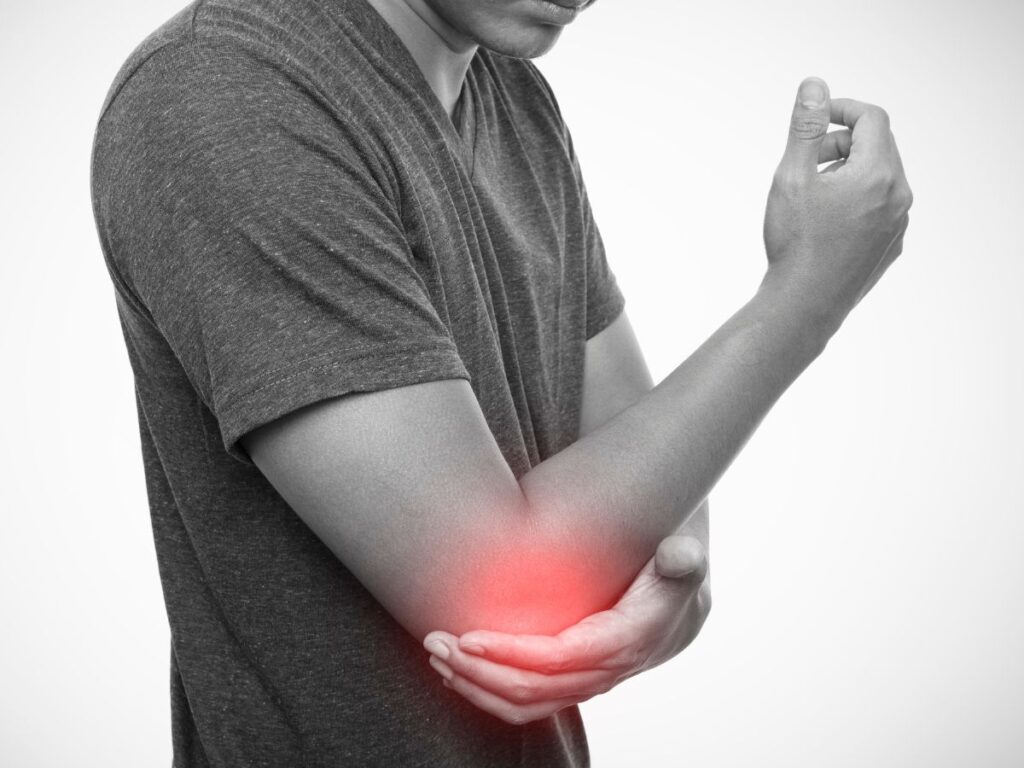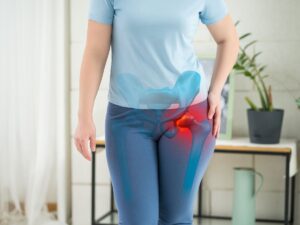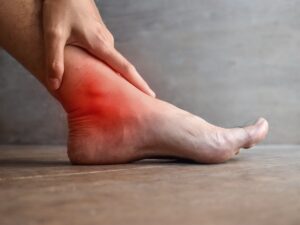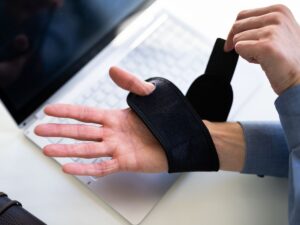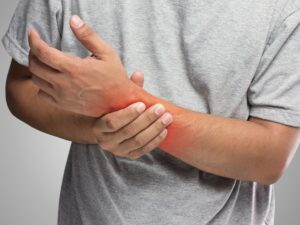Understanding Arm and Elbow Pain
Arm and elbow pain can arise from a variety of issues involving muscles, tendons, ligaments, or nerves. Because the arm and elbow are essential for most everyday activities—whether lifting grocery bags, typing on a computer, or engaging in sports—even minor discomfort can significantly disrupt your routine. The elbow itself is a hinge joint formed by three bones: the humerus (upper arm), radius, and ulna (forearm). Surrounding tissues, including the biceps, triceps, and forearm muscles, enable movements such as bending, extending, and rotating the arm. In addition, nerves like the ulnar nerve pass through tight tunnels around the elbow, making them vulnerable to compression injuries. When pain persists, it may be a sign of an underlying issue—such as tendonitis, bursitis, or degenerative joint changes—that warrants targeted intervention.
Common Causes of Arm and Elbow Discomfort
Many factors lead to arm and elbow pain. Overuse injuries, such as tennis elbow (lateral epicondylitis) or golfer’s elbow (medial epicondylitis), result from repetitive wrist and arm motions that strain the tendons attaching to the elbow. Poor biomechanics and weak supporting muscles can exacerbate these conditions, creating microtears that spark inflammation. Other contributors include bursitis, which occurs when the fluid-filled sacs cushioning the joint become irritated; nerve entrapments, like cubital tunnel syndrome; or direct trauma from falls and sports collisions. Even chronic muscle tension in the neck and shoulder area can radiate pain down to the elbow. Understanding these various causes helps pinpoint the right treatments—ranging from simple rest and ice to physical therapy or more advanced procedures.
The Ripple Effect on Daily Life
Persistent pain in the arm or elbow often affects multiple aspects of daily living. Routine tasks like lifting a cup of coffee, brushing your hair, or opening doors become uncomfortable and frustrating. Athletes dealing with tendinopathies may struggle to maintain peak performance, leading to interruptions in training or even forced breaks from competition. Office workers who spend hours typing can experience progressively worsening elbow soreness if wrist alignment and desk ergonomics are ignored. Over time, this constant pain can lead to secondary issues, such as compensatory movements and muscle imbalances. These compensations may eventually spread discomfort to the shoulders, neck, or wrists. Anxiety and stress over recurrent pain can further compound the problem. Addressing arm and elbow pain promptly not only improves comfort but also helps maintain a healthy, active lifestyle.
Noninvasive Approaches and Self-Care
Often, the first line of defense against mild to moderate arm and elbow pain involves conservative measures that focus on reducing inflammation, promoting healing, and preventing further damage. Some effective self-care strategies include:
- Rest and Activity Modification: Temporarily avoiding or minimizing the motions that aggravate pain gives tissues a chance to recover.
- Ice and Heat Therapy: Applying ice within the initial 48–72 hours reduces inflammation, while heat later encourages blood flow to speed healing.
- Over-the-Counter Medication: NSAIDs like ibuprofen can help manage pain and inflammation, though they’re typically used short-term.
- Bracing or Splinting: Elastic wraps or specialized braces can stabilize the elbow joint, reducing strain on irritated tendons or ligaments.
Consistent application of these simple remedies can often alleviate minor aches before they become chronic. Nonetheless, if symptoms persist or worsen, seeking professional evaluation is essential. A medical exam can identify whether tendon damage or nerve involvement requires more targeted treatment. For those seeking comprehensive strategies, additional guidance can be found at Arm & Elbow Pain Relief, where specific therapies and personalized plans are detailed.
The Role of Chiropractic Care
Chiropractic treatment focuses on improving musculoskeletal alignment and function. When dealing with arm and elbow pain, chiropractors like Dr. Elham assess not just the elbow but also the wrist, shoulder, and cervical spine to uncover any contributing factors. Small misalignments in these interconnected areas can increase tension on arm muscles and tendons, exacerbating pain in the elbow joint. By performing gentle adjustments, chiropractors restore proper joint mechanics, often reducing nerve irritation and muscle strain. Additional soft tissue techniques—such as myofascial release or instrument-assisted mobilizations—further alleviate tension in the forearm, biceps, or triceps. This integrated approach means less recurring inflammation and a smoother healing process. Many patients find that regular chiropractic sessions combined with home exercises foster sustained relief, improved range of motion, and better overall arm function.
Physical Therapy for Targeted Rehabilitation
Physical therapists employ a variety of interventions to address arm and elbow pain. These may include ultrasound therapy to reduce inflammation, manual techniques to break down scar tissue, and dry needling for trigger point release. Yet, one of the most critical components of physical therapy is a customized exercise regimen. Therapists tailor exercises to strengthen the muscles around the elbow, increase flexibility, and promote healthy movement patterns. By correcting muscle imbalances—like overly tight wrist flexors or weak forearm extensors—physical therapy stabilizes the elbow joint and helps prevent re-injury. Therapists often provide ergonomic advice, ensuring that patients adjust their workspace or sports technique to minimize repetitive stress on the joint. This holistic approach empowers individuals to manage their pain effectively, reinforcing gains made during in-office sessions with daily routines at home.
Exercises to Strengthen and Stabilize
A well-rounded exercise program is crucial in both recovering from and preventing arm and elbow pain. Examples of beneficial drills include:
- Eccentric Wrist Curls: Using a light dumbbell, rest your forearm on a table with your palm facing up. Lift the weight with both hands, then slowly lower it with just your injured arm. Eccentric movements help strengthen tendons in conditions like tennis or golfer’s elbow.
- Forearm Pronation/Supination: Hold a small weight or hammer in your hand, bending the elbow at 90 degrees. Slowly rotate the forearm so your palm goes from facing down (pronation) to facing up (supination). This motion targets deeper stabilizers around the elbow.
- Triceps Kickbacks: Lean forward at the hips, keeping your back neutral. Holding a light weight, bend your elbow, then extend your arm behind you, focusing on engaging the triceps. Strengthening the back of the arm can alleviate strain on the elbow joint.
- Isometric Grips: Squeeze a soft rubber ball or grip trainer for a few seconds, then release. Gradually increase the duration as your forearm muscles strengthen.
Begin each exercise with low resistance—like a one- or two-pound weight or a light resistance band—and perform 2–3 sets of 8–12 repetitions. Monitor how you feel during and after each session. Mild soreness is normal, but sharp or worsening pain signals the need to adjust technique or reduce intensity. Over time, you can progress to heavier weights or more challenging variations.
Mind-Body Techniques
Chronic arm and elbow discomfort can trigger stress and anxiety, particularly if the pain interrupts daily activities or hinders work and hobbies. Techniques such as meditation, yoga, and controlled breathing help mitigate the mental toll of persistent pain. By promoting relaxation, these methods can lower muscle tension and interrupt the body’s stress response, which often aggravates inflammation. Gentle yoga sequences, for instance, incorporate poses that lengthen the arms and relieve shoulder tightness—factors that can indirectly benefit the elbow. Mindfulness practices encourage body awareness, helping you recognize early warning signs of fatigue or overexertion, making it easier to pace your activities. While not a substitute for structured physical therapies, mind-body approaches support a holistic recovery strategy.
Advanced Interventional Procedures
For severe or persistent arm and elbow pain, doctors might recommend interventions that go beyond conservative measures. Corticosteroid injections, administered near inflamed tendons or bursa, help quickly reduce swelling and discomfort, although their benefits may be short-term. Platelet-Rich Plasma (PRP) therapy injects concentrated platelets to accelerate tissue repair, which some studies suggest can be particularly beneficial for stubborn tendinopathies. Ultrasound-guided needle tenotomy targets damaged tissue, stimulating a healing response. In rare cases, surgical intervention may be necessary to remove damaged tendon tissue, release nerve entrapments, or address structural abnormalities, such as bone spurs. While these procedures can offer significant relief, they carry inherent risks like infection or incomplete healing. Consequently, many clinicians recommend trying multiple conservative therapies first to rule out simpler pathways to recovery.
Ergonomics and Everyday Modifications
Addressing underlying ergonomic issues is vital for preventing relapses. Small adjustments—like positioning your keyboard and mouse so your wrists remain in neutral alignment—can substantially reduce strain on the elbow. If you lift heavy objects at work, adopt proper body mechanics by bending your knees and keeping loads close to your torso. For athletes, analyzing technique in sports that involve repetitive arm motions can pinpoint subtle flaws that strain the elbow joint over time. Simple changes, like selecting the correct racquet grip size in tennis or adjusting swing mechanics in golf, can alleviate ongoing tendon stress. At home, use lightweight utensils if stirring or chopping exacerbates elbow pain. These personalized tweaks keep inflammation at bay and allow the arm’s supportive structures to heal more effectively. Comprehensive advice on ergonomic solutions is available through Arm & Elbow Pain Relief, which outlines how daily habits impact long-term health.
Prevention and Maintenance
Once pain subsides, many patients assume they can return to their usual routines without further modifications. However, continuing exercises, stretches, and ergonomic best practices is essential for preventing recurrence. Periodic check-ins with healthcare professionals like Dr. Elham can help catch early warning signs of muscle imbalances or joint misalignment. Maintaining a balanced exercise regimen that includes stretching, strengthening, and cardiovascular workouts helps sustain the gains achieved during rehab. Additionally, focusing on adequate hydration, sleep, and nutrition provides the raw materials for tissue repair. Those prone to repetitive strain injuries benefit from gradually increasing activity intensity or duration, allowing the arm and elbow time to adapt. A mindful, consistent approach to self-care fosters resilience, reducing the likelihood of setbacks. If you need ongoing support, Arm & Elbow Pain Relief resources offer tailored follow-up routines and professional guidance, ensuring that you stay on the path to long-lasting comfort and mobility.

